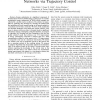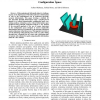92 search results - page 7 / 19 » Minimal energy path planning for wireless robots |
WIOPT
2010
IEEE
13 years 5 months ago
2010
IEEE
—Energy optimization is a significant component of Wireless Sensor Network (WSN) design. In this paper we consider transmission energy optimization in WSNs where messages are co...
ICRA
2010
IEEE
13 years 4 months ago
2010
IEEE
Abstract-- Motion planning of deformable objects is challenging due to the high degrees-of-freedom inherent in deformation as well as the computational cost of producing physically...
ISCC
2009
IEEE
14 years 1 months ago
2009
IEEE
Routing protocols for Wireless Sensor Networks (WSN) face three major performance challenges. The first one is an efficient use of bandwidth that minimizes the transfer delay of p...
INFORMATIKTAGE
2008
13 years 8 months ago
2008
: Economical power use is essential to allow for long-lasting operation of wireless sensor networks. This applies equally to linear sensor networks as they emerge when sensors are ...
ICRA
2007
IEEE
14 years 1 months ago
2007
IEEE
Abstract— Sampling-based algorithms have dramatically improved the state of the art in robotic motion planning. However, they make restrictive assumptions that limit their applic...


